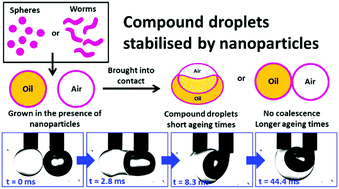当前位置:
X-MOL 学术
›
Soft Matter
›
论文详情
Our official English website, www.x-mol.net, welcomes your
feedback! (Note: you will need to create a separate account there.)
Effect of morphology on interactions between nanoparticle-stabilised air bubbles and oil droplets†
Soft Matter ( IF 2.9 ) Pub Date : 2018-03-06 00:00:00 , DOI: 10.1039/c7sm02280h Victoria J. Cunningham 1, 2, 3, 4 , Emma C. Giakoumatos 5, 6, 7, 8 , Melissa Marks 5, 6, 7, 8 , Steven P. Armes 1, 2, 3, 4 , Erica J. Wanless 5, 6, 7, 8
Soft Matter ( IF 2.9 ) Pub Date : 2018-03-06 00:00:00 , DOI: 10.1039/c7sm02280h Victoria J. Cunningham 1, 2, 3, 4 , Emma C. Giakoumatos 5, 6, 7, 8 , Melissa Marks 5, 6, 7, 8 , Steven P. Armes 1, 2, 3, 4 , Erica J. Wanless 5, 6, 7, 8
Affiliation

|
High-speed video analysis has enabled the interaction between a pair of millimetre-sized air bubbles to be studied in aqueous solution. The bubbles were grown in the presence of either poly(glycerol monomethacrylate)–poly(benzyl methacrylate) (PGMA–PBzMA) diblock copolymer spheres or poly(glycerol monomethacrylate)–poly(2-hydroxypropyl methacrylate)–poly(benzyl methacrylate) (PGMA–PHPMA–PBzMA) triblock copolymer worms prepared by polymerisation-induced self-assembly (PISA). A reduction in interfacial tension relative to air bubbles grown in the absence of nanoparticles indicated the adsorption of nanoparticles at the air–water interface. A concentration of 0.01% w/v PGMA–PBzMA spheres conferred air bubble stability after just 30 s interfacial ageing with stirring, whereas 300 s ageing was required for worms to prevent coalescence at the same copolymer concentration. However, longer coalescence times with interfacial age suggested greater worm adsorption on the air bubbles during this period. In striking contrast, although stable millimetre-sized n-dodecane droplets were obtained in the presence of 0.01% w/v copolymer worms, the copolymer spheres did not prevent coalescence at this low concentration. Finally, the multiphase interaction and stability of immiscible fluids in the presence of either spheres or worms was assessed. More specifically, an n-dodecane oil droplet and an air bubble were grown separately in the presence of either the spheres or worms and then brought into contact. In the absence of any nanoparticles, aqueous film drainage resulted in the formation of a compound droplet consisting of an air lens on the oil droplet. In the presence of 0.01% w/v nanoparticles, ageing times of either 30 s or 120 s were required to prevent formation of compound droplets when using spheres and worms, respectively. Moreover, this asymmetric system required much shorter ageing times in the presence of adsorbed nanoparticles to gain stability compared to either the symmetric air bubble or oil droplet systems. This stability is attributed to a bridging nanoparticle monolayer between the oil droplet and the air bubble.
中文翻译:

形态对纳米颗粒稳定的气泡与油滴之间相互作用的影响†
高速视频分析使得能够在水溶液中研究一对毫米大小的气泡之间的相互作用。气泡是在聚(单甲基丙烯酸甘油酯)-聚(甲基丙烯酸苄酯)(PGMA-PBzMA)二嵌段共聚物球或聚(单甲基丙烯酸甘油)-聚(甲基丙烯酸2-羟丙酯)-聚(甲基丙烯酸苄酯)存在下生长的–PHPMA–PBzMA)由聚合诱导的自组装(PISA)制备的三嵌段共聚物蠕虫。相对于在不存在纳米颗粒的情况下产生的气泡,界面张力的降低表明纳米颗粒在空气-水界面处的吸附。浓度为0.01%w / v的PGMA–PBzMA球在搅拌下仅经过30 s的界面时效,就会赋予气泡稳定性,蠕虫需要300 s的老化时间,以防止在相同的共聚物浓度下发生聚结。但是,随着界面年龄的增长,聚结时间越长,表明在此期间蠕虫对气泡的吸附越大。与之形成鲜明对比的是,尽管尺寸稳定在有0.01%w / v共聚物蜗杆的情况下获得了正十二烷液滴,在这种低浓度下,共聚物球体无法防止聚结。最后,评估了球体或蠕虫存在时不混溶流体的多相相互作用和稳定性。更具体地,Ñ在球体或蠕虫的存在下,十二烷油滴和气泡分别生长,然后接触。在不存在任何纳米颗粒的情况下,水膜排水导致在油滴上形成由气镜组成的复合滴。在存在0.01%w / v的纳米粒子的情况下,分别使用球形和蠕虫时,需要30 s或120 s的老化时间来防止形成化合物液滴。此外,与对称气泡或油滴系统相比,在存在吸附的纳米粒子的情况下,这种不对称系统需要更短的老化时间才能获得稳定性。该稳定性归因于油滴和气泡之间的桥接纳米颗粒单层。
更新日期:2018-03-06
中文翻译:

形态对纳米颗粒稳定的气泡与油滴之间相互作用的影响†
高速视频分析使得能够在水溶液中研究一对毫米大小的气泡之间的相互作用。气泡是在聚(单甲基丙烯酸甘油酯)-聚(甲基丙烯酸苄酯)(PGMA-PBzMA)二嵌段共聚物球或聚(单甲基丙烯酸甘油)-聚(甲基丙烯酸2-羟丙酯)-聚(甲基丙烯酸苄酯)存在下生长的–PHPMA–PBzMA)由聚合诱导的自组装(PISA)制备的三嵌段共聚物蠕虫。相对于在不存在纳米颗粒的情况下产生的气泡,界面张力的降低表明纳米颗粒在空气-水界面处的吸附。浓度为0.01%w / v的PGMA–PBzMA球在搅拌下仅经过30 s的界面时效,就会赋予气泡稳定性,蠕虫需要300 s的老化时间,以防止在相同的共聚物浓度下发生聚结。但是,随着界面年龄的增长,聚结时间越长,表明在此期间蠕虫对气泡的吸附越大。与之形成鲜明对比的是,尽管尺寸稳定在有0.01%w / v共聚物蜗杆的情况下获得了正十二烷液滴,在这种低浓度下,共聚物球体无法防止聚结。最后,评估了球体或蠕虫存在时不混溶流体的多相相互作用和稳定性。更具体地,Ñ在球体或蠕虫的存在下,十二烷油滴和气泡分别生长,然后接触。在不存在任何纳米颗粒的情况下,水膜排水导致在油滴上形成由气镜组成的复合滴。在存在0.01%w / v的纳米粒子的情况下,分别使用球形和蠕虫时,需要30 s或120 s的老化时间来防止形成化合物液滴。此外,与对称气泡或油滴系统相比,在存在吸附的纳米粒子的情况下,这种不对称系统需要更短的老化时间才能获得稳定性。该稳定性归因于油滴和气泡之间的桥接纳米颗粒单层。











































 京公网安备 11010802027423号
京公网安备 11010802027423号